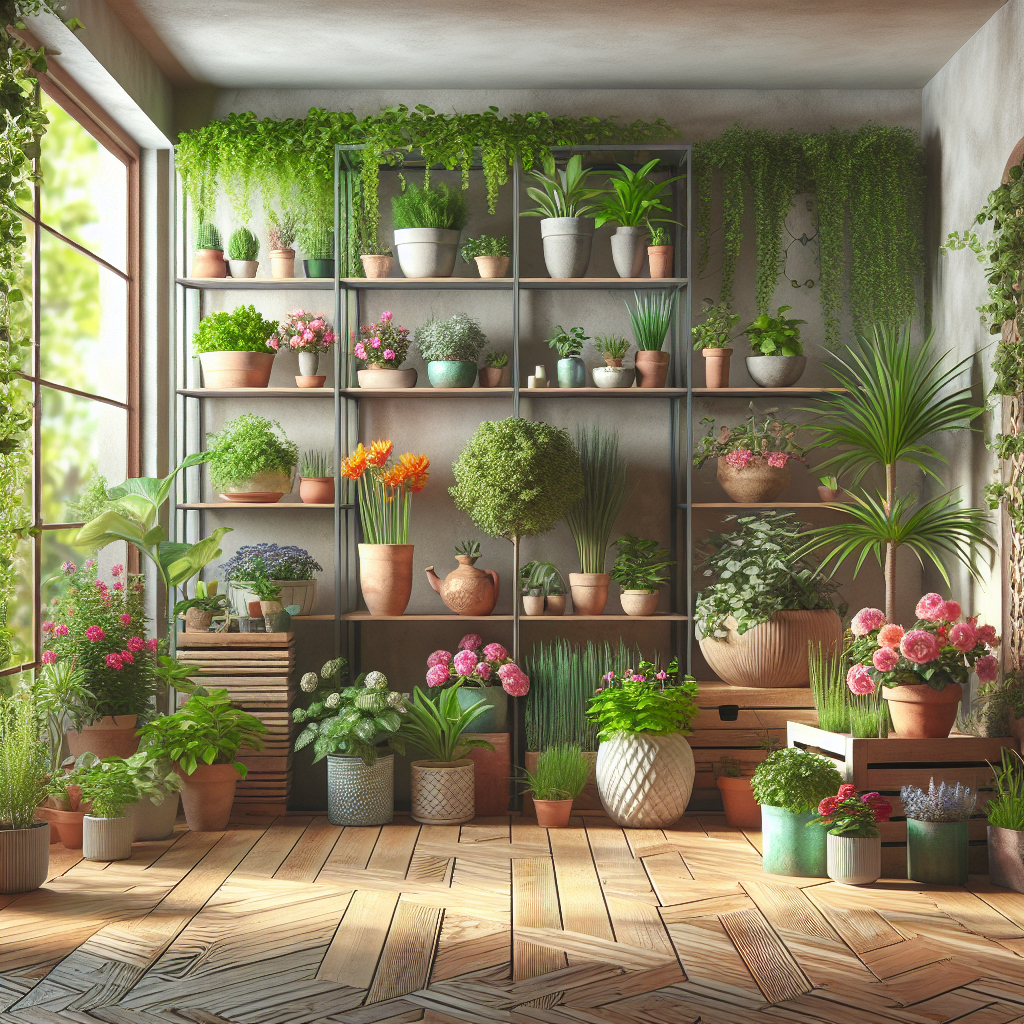
Imagine transforming your ordinary outdoor space into a vibrant and lush oasis with the help of garden containers. These versatile beauties offer a world of gardening possibilities, even if you have limited space or lack a traditional garden bed. Whether you have a cozy balcony, a sunny porch, or a small backyard, container gardens allow you to unleash your green thumb and create a personalized sanctuary right outside your doorstep. With their ability to inject life and color into any environment, it’s no wonder that garden containers have become the go-to solution for urban dwellers and suburban homeowners alike. So, let’s explore the exciting world of container gardening and unlock the secrets to cultivating a blooming haven that will leave both your guests and your neighborhood in awe.

Choosing the Right Containers
When it comes to container gardening, choosing the right containers is crucial for the success of your plants. There are several factors to consider when selecting containers, including the size and root system of the plant, drainage, materials suitable for your climate, and aesthetic appeal.
Consider the plant’s size and root system
Before choosing a container, it’s important to consider the size and root system of the plant you want to grow. Some plants have deep root systems and require larger containers, while others have more shallow roots and can thrive in smaller pots. It’s essential to choose a container that provides enough space for the plant’s roots to grow and spread.
Select containers with good drainage
Proper drainage is essential for container gardening. If the container does not have adequate drainage holes at the bottom, excess water can accumulate, leading to root rot and other problems. When selecting containers, look for ones with drainage holes or consider drilling holes in the bottom if necessary. This will ensure that the excess water can drain out and prevent waterlogged soil.
Choose materials that are suitable for your climate
Container materials can impact the overall health and success of your plants. Some materials, such as terracotta and clay, allow for good airflow and moisture regulation but are prone to cracking in freezing temperatures. On the other hand, plastic and fiberglass containers are lightweight and more durable but may not provide as good of drainage. Consider the climate in your area and choose materials that are suitable for the conditions your containers will be exposed to.
Consider the aesthetic appeal of different container types
Container gardening not only offers the opportunity to grow plants but also allows for creative expression. Consider the aesthetic appeal of different container types and how they will complement your outdoor space or indoor decor. From traditional terracotta pots to sleek and modern fiberglass containers, there are endless options to choose from. Select containers that not only provide a suitable environment for your plants but also enhance the overall visual appeal of your container garden.
Container Considerations
When it comes to container gardening, there are several factors to consider to ensure the health and growth of your plants. Understanding the impact of container size, choosing the right soil mix, providing adequate water and drainage, considering sunlight and positioning, and utilizing vertical space are all important considerations.
Understanding the impact of container size on plant growth
The size of the container directly impacts the growth and development of your plants. If the container is too small, the plant’s roots may become rootbound, inhibiting growth and nutrient uptake. On the other hand, if the container is too large, it can lead to excessive moisture retention and poor root development. Choose a container size that allows for proper root growth and provides enough space for the plant to thrive.
Choosing the right soil mix
The soil mix used in container gardening plays a vital role in providing the necessary nutrients, aeration, and drainage for plants. Avoid using garden soil alone, as it tends to be heavy and retains too much moisture. Instead, opt for a well-draining potting mix that is specifically formulated for container gardening. This will ensure that your plants receive the right balance of nutrients and moisture.
Providing adequate water and drainage
Proper watering is crucial in container gardening. Unlike plants in the ground, container plants rely on the gardener to supply them with water. Be mindful not to overwater or underwater your plants. Monitor the moisture level of the soil and water accordingly. Additionally, ensure that your containers have adequate drainage to prevent waterlogged soil, which can lead to root rot and other issues.
Considering sunlight and positioning
Different plants have varying sunlight requirements. Before placing your containers, consider the amount of sunlight the specific plants need and choose appropriate locations. Some plants thrive in full sun, while others prefer partial shade or even full shade. Observing the sun patterns in your garden or the available indoor light will help you position your containers for optimal plant growth.
Utilizing vertical space
Maximize your container garden’s potential by utilizing vertical space. Hanging baskets, trellises, and vertical planters are excellent options for growing plants such as vines, trailing flowers, and herbs. By taking advantage of vertical space, you can create a lush and abundant garden even in limited areas.

Selecting Plants for Container Gardens
Selecting the right plants for your container garden is essential for their overall health and success. Consider the suitability of plants for container gardening, the growth habits and space requirements of each plant, and choose plants based on the container’s location and the desired seasonal interest and variety.
Identifying plants suitable for container gardening
Not all plants thrive in containers, so it’s important to choose plants that are well-suited for container gardening. Look for plants with compact or dwarf varieties, as they generally adapt better to the limited space of containers. Additionally, consider plants that are known to have shallow root systems, as they are more likely to thrive in containers.
Considering the plant’s growth habit and space requirements
Each plant has its own growth habits and space requirements, so it’s crucial to consider these factors when selecting plants for your container garden. Some plants, such as tomatoes and peppers, require larger containers to accommodate their growth and support structures. Others, like lettuce or herbs, may only need smaller containers. Research the specific plants you want to grow and ensure that each one has enough space to thrive.
Choosing plants based on the container’s location (sun, shade, indoors)
Consider the location of your containers when choosing plants for your container garden. Some plants thrive in full sun, while others prefer partial shade or even full shade conditions. If you are growing plants indoors, consider the available light and select plants that can thrive in lower light conditions. Matching the plant’s preferences for sunlight and shade to the conditions of your containers’ location will help ensure their success.
Selecting plants for seasonal interest and variety
One of the joys of container gardening is the opportunity to change and experiment with different plants throughout the seasons. Choose plants that offer seasonal interest, such as blooming flowers or colorful foliage, to keep your container garden visually appealing. Additionally, consider incorporating a variety of plants with different textures, heights, and growth habits to create a dynamic and diverse container garden.

Caring for Container Gardens
Once you have established your container garden, proper care and maintenance are crucial for the ongoing health and vitality of your plants. This includes watering techniques, fertilizing, pest and disease control, pruning, grooming, and winterizing your container garden.
Watering techniques for container plants
Container plants require regular and consistent watering. The frequency of watering depends on the specific plant’s needs, environmental conditions, and container size, among other factors. It’s important to water thoroughly, allowing the water to reach the root zone, but be careful not to overwater, as it can lead to root rot. Monitor the moisture level of the soil and adjust your watering schedule accordingly.
Fertilizing container plants
Container-grown plants may require regular fertilization to meet their nutrient needs, as the nutrients in the potting mix can deplete over time. Use a balanced, water-soluble fertilizer specifically formulated for container plants and follow the instructions for application rates. Regular fertilization will help promote healthy growth and vibrant blooms.
Controlling pests and diseases
Container plants are not immune to pests and diseases. Regularly inspect your plants for signs of pests such as aphids, mealybugs, or spider mites. If you notice any infestations, promptly take appropriate measures such as using organic insecticidal soap or introducing beneficial insects to control them. Similarly, keep an eye out for any signs of diseases, such as leaf spots or powdery mildew. Proper sanitation, good air circulation, and regular monitoring will help prevent and control pest and disease issues.
Pruning and grooming container plants
Pruning and grooming container plants are essential maintenance tasks to keep them looking their best. Regularly prune off any dead or damaged foliage or spent flowers to promote new growth and improve the overall appearance of your container garden. Additionally, consider pinching back certain plants to encourage bushier growth and prevent them from becoming leggy.
Winterizing container gardens
In colder climates, container plants need special attention during the winter months. The freezing temperatures can damage both the plants and containers. Before winter arrives, bring sensitive plants indoors or move them to a protected area. Insulate containers with bubble wrap or hessian to provide extra protection against freezing temperatures. Mulching the soil surface with straw or other organic materials can also help insulate the roots. Additionally, reduce watering frequency during winter to prevent excess moisture from freezing and damaging the plants’ roots.






